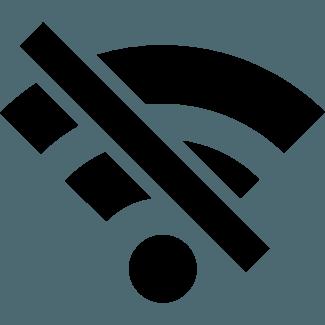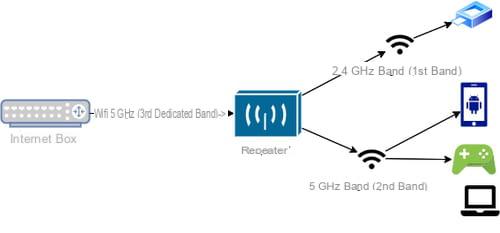
Problems encountered
Wireless technology has come a long way in recent years, but it is still not uncommon to hear that the WiFi connection is weak / unstable.
The cause lies mainly in the internet box: increasingly smaller in size, we do not necessarily have control over the choice of its location: single ADSL arrival, PTO located in a corner of the house ...
Result: the propagation of the WiFi signal is not homogeneous.
Another reason, the French specificity: the very concept of the box.
Although we can now see internet boxes in our European neighbors, in some countries it is still customary, for performance reasons (and choice for users) to have a separate modem, a separate router as well as a separate access point.
Solutions
Several solutions are available to you, the budget and the current configuration of your house / apartment will guide you in making the right choice.
The Wi-Fi repeater
Traditional repeaters (small boxes plugged into the electrical outlet directly) connect to your existing access point (your Internet box for example) and redistribute the signal from the location where they are connected.
Benefits
- Ease of installation
- No work required
- Economical solution
Drawbacks
- Unsuitable solution for large housing areas
- Reduced flow (the repeater is an intermediary between you and the box, the flow is divided by 2)
- Unsuitable solution for gaming or streaming (continuous stable flow required, high latency)
Possible configurations
Two configurations are possible:
In the first, easy to use, the repeater is placed between you and the box and communicates exclusively in Wifi.
This configuration is not recommended, especially if you have a Fiber connection: paradoxically, the higher your speed, the less suitable this solution (you will not be able to make the most of your connection).

In the second configuration, your repeater is connected to your box via a long Ethernet cable.
It is therefore no longer really a repeater, but a real wifi access point, more independent of the box.
The ping (latency) will be reduced, the WiFi speed will not be divided by 2, you will find a very good speed on arrival.

The Tri-Band Repeater
If you cannot run an Ethernet cable between your Internet Box and the repeater but you want to have an effective solution, you can opt for the Tri-Band repeater.
Indeed, this type of repeater has, as the name suggests, three Wi-Fi bands:
- A first 2,4 GHz band of long range but subject to disturbances (recommended for old devices or wireless printers, wireless cameras, remote controllable devices etc.)
- A second 5 GHz band with a shorter range but less sensitive to disturbances, with a higher theoretical speed (recommended for laptops, consoles, Smart TVs etc.)
- A third 5 GHz band dedicated to communication between the Internet box and the repeater
The presence of the third band will reduce the latency between your wireless device and your internet box and will not divide the speed by two as is the case with conventional repeaters. Obviously, they are more expensive to buy.

The Mesh router
The previous solutions are not suitable for very large surfaces.
One repeater may not be sufficient.
In such a case, it is worth investing in a Mesh solution.
Indeed, if you put several repeaters and the repeater at the end of the chain has another repeater as its source, the throughput will be very low at the end and a very high latency.
In addition, if you move within your home, the device does not automatically go to the strongest signal: you will have to be completely out of Wi-Fi range for the device to scan again and reconnect. Or if not, proceed manually by deactivating and reactivating the Wi-Fi. In short, it is not a "smart" solution.
In the case of a Mesh, a first box is connected via Ethernet to your Internet Box.
The other boxes can be connected via Ethernet to each other or communicate via Wi-Fi (the best is to be able to connect them via Ethernet).
This smart solution will allow automatic switching: as soon as you move away from the Wifi zone of a box, your device automatically switches to the nearest box.
As with classic repeaters, there are Bi-Band Mesh (ideal if you can connect them to each other by an Ethernet cable) and Tri-Band Mesh (if you want to connect them via Wifi).
It is recommended, in order not to disrupt the automatic switchover, to deactivate the Box's WiFi.
In addition, if your Box allows it, you should activate Bridge mode, so as not to have two local networks.
With such a solution, the latency is low, the switching between the boxes is automatic.
For now, this is the best solution in terms of wireless connection.


























